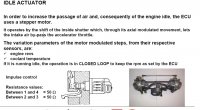ohiorider
Cruisin' Guzzisti
What's worse --- this issue or an oil thread? :mrgreen:
I am aware the stepper can be totally disabled by using either an in line valve in the hose between the stepper and the airbox (or simply plugging it 100% of the time), but my bike seems so close to operating properly, I would like not to noodle with the stepper motor. It would make sense, I'm sure, to plug the hose and see if the engine does stay at 1100 RPM once warm. If that cures the issue, well, it'll be time to install either Todd's electrically controlled switch or a manually operated valve in line with the hose and quit fighting it.
Is there an adjustment one can access to change how the stepper motor actuates the throttle butterflies? Obviously, I'm NOT mucking with the 'sacred screw.' I've taken the advice of one of the tech advisors on this forum (tweaking the lengths of the throttle open/throttle close cables at the handlebar). The thinking was if the closing cable was slightly shortened (after slightly lengthening the opening cable), I'd be able to apply light force which would cause the idle to drop when at a stop. The throttle return springs are quite light on this bike. Currently, when the bike begans idling at 1500+rpm, I can lightly pull on the throttle linkage with my right hand, and the idle immediately drops to the desired speed. As soon as I release it, the idle speed goes back up to 1500-1600rpm. The cable adjustment idea made sense to me, unfortunately tweaking the cable length didn't appear to work. (Note - at the time the cable adjustment was suggested, the hanging throttle could be temporarily cured with a shot of WD40 on the throttle linkage springs)
I'll be doing a spring tuneup (plugs, TB balancing, TPS reset) which may help somewhat, but it appears to be more of a mechanical issue vs a tuning issue. Doing these things last year, plus canisterectomy, got rid of all the popping on overrun, but not the higher idle that takes place when the temps are on the cool side.
The drawings in the Teo Lamer parts manuals provide an illustration of the throttle bodies, but don't show (a) where the throttle cables attach, or (b) the linkage between the stepper motor and the TBs. And right now, it's just too cold in the garage to start removing the fuel tank to get a good look at the throttle linkage and cable attachment points.
Thanks for any thoughts on this matter.
Bob
I am aware the stepper can be totally disabled by using either an in line valve in the hose between the stepper and the airbox (or simply plugging it 100% of the time), but my bike seems so close to operating properly, I would like not to noodle with the stepper motor. It would make sense, I'm sure, to plug the hose and see if the engine does stay at 1100 RPM once warm. If that cures the issue, well, it'll be time to install either Todd's electrically controlled switch or a manually operated valve in line with the hose and quit fighting it.
Is there an adjustment one can access to change how the stepper motor actuates the throttle butterflies? Obviously, I'm NOT mucking with the 'sacred screw.' I've taken the advice of one of the tech advisors on this forum (tweaking the lengths of the throttle open/throttle close cables at the handlebar). The thinking was if the closing cable was slightly shortened (after slightly lengthening the opening cable), I'd be able to apply light force which would cause the idle to drop when at a stop. The throttle return springs are quite light on this bike. Currently, when the bike begans idling at 1500+rpm, I can lightly pull on the throttle linkage with my right hand, and the idle immediately drops to the desired speed. As soon as I release it, the idle speed goes back up to 1500-1600rpm. The cable adjustment idea made sense to me, unfortunately tweaking the cable length didn't appear to work. (Note - at the time the cable adjustment was suggested, the hanging throttle could be temporarily cured with a shot of WD40 on the throttle linkage springs)
I'll be doing a spring tuneup (plugs, TB balancing, TPS reset) which may help somewhat, but it appears to be more of a mechanical issue vs a tuning issue. Doing these things last year, plus canisterectomy, got rid of all the popping on overrun, but not the higher idle that takes place when the temps are on the cool side.
The drawings in the Teo Lamer parts manuals provide an illustration of the throttle bodies, but don't show (a) where the throttle cables attach, or (b) the linkage between the stepper motor and the TBs. And right now, it's just too cold in the garage to start removing the fuel tank to get a good look at the throttle linkage and cable attachment points.
Thanks for any thoughts on this matter.
Bob

